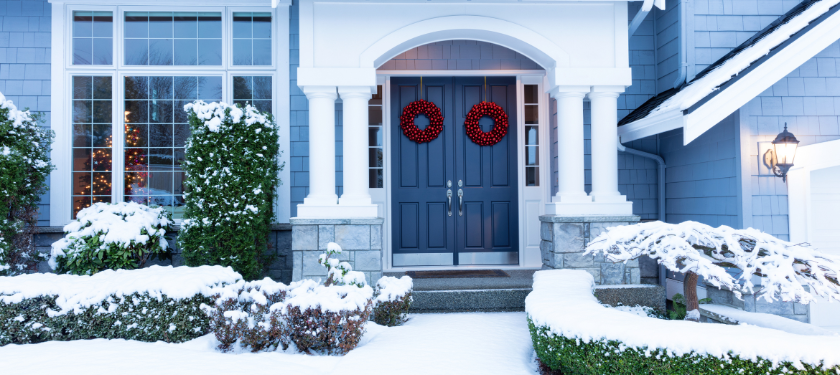Choosing the best exterior paint for Michigan climate isn’t just a matter of color or brand preference. It’s about chemistry, application timing, and matching products to the realities of lake-effect moisture, wide temperature swings, and relentless UV. In this guide, Speese Painting distills decades of residential exterior painting experience across West Michigan into practical, brand-agnostic recommendations to help you select truly weather-resistant exterior paint—and get the longest life from every coat.

Why Michigan’s Climate Demands a Different Approach
Michigan homes face four stressors that quickly separate average coatings from the best exterior paints for Michigan’s climate:
- Freeze–thaw cycles: Spring and fall bring repeated temperature swings that cause substrates to expand and contract. Paint must flex with the surface or it will crack, chip, or lose adhesion.
- Moisture and humidity: Proximity to the Great Lakes means elevated moisture, wind-driven rain, and snow load. Water intrusion beneath paint films is the fastest path to failure.
- UV exposure: Even in cold months, UV light breaks down resins and fades pigments. A premium, UV-stable binder and high-quality colorants matter.
- Biological growth: Shade, tree cover, and moisture create conditions for mildew and algae, especially on the north sides of homes and along trim.
When you choose weather-resistant exterior paint built around flexible, UV-stable resins—and pair it with proper prep—you reduce peeling, extend color life, and delay your next repaint by years.
The Chemistry That Wins in Michigan
Not all exterior paints are created equal. Here’s what to look for if you want durable, weather-resistant exterior paint that stands up to freeze–thaw cycles.
100% Acrylic Latex as the Baseline
For most West Michigan exteriors, 100% acrylic latex is the sweet spot. It offers:
- Superior adhesion to wood, fiber cement, and previously painted surfaces.
- Flexibility to move with seasonal expansion/contraction.
- Breathability to allow incidental moisture vapor to escape, reducing blistering.
Acrylic-urethane hybrids can add extra hardness and improved block resistance on trim and doors while still keeping good flexibility—excellent for high-touch areas that need a tougher finish without sacrificing Michigan-ready performance.
When Elastomeric Coatings Make Sense
On stucco, masonry, and hairline-cracked surfaces, elastomeric systems can bridge small cracks and keep bulk water out. They’re not for every substrate, and they require precise prep and compatible primers. Used correctly, they provide exceptional weather-resistant protection in wind-driven rain and severe freeze–thaw conditions.
Pigments and UV Stability
Rich, fade-resistant color comes from high-quality pigments and UV-stable binders. Deep, saturated hues benefit from premium formulations that resist chalking and color fade. If your color plan leans dark—popular on modern exteriors—step up to top-tier lines that are engineered for UV resistance.
Substrate-Specific Advice
Different surfaces move and weather differently. Matching the product to the substrate is a core part of choosing the best exterior paint for Michigan climate.
Wood (Cedar, Pine, Trim Boards)
- Primer: Use an exterior, stain-blocking primer that seals tannins on cedar and redwood and locks down minor chalk.
- Topcoat: Two coats of 100% acrylic latex in a siding-appropriate sheen (usually satin or low-lustre).
- Why it works: Acrylic systems flex with seasonal changes and breathe, reducing blister risk. For aging wood, consider a penetrating primer to reinforce weathered fibers.
Fiber Cement (Hardie®, etc.)
- Primer: Most panels come factory-primed; spot-prime raw edges and fastener heads.
- Topcoat: Acrylic latex finish with higher UV stability.
- Why it works: Low moisture absorption of fiber cement plus flexible acrylic equals long cycles between repaints.
Masonry and Stucco
- Primer: Alkali-resistant masonry primer after the surface has fully cured (new stucco requires adequate cure time).
- Topcoat: Acrylic masonry paint or elastomeric when crack-bridging is needed.
- Why it works: Masonry breathes; coatings must let vapor escape while keeping liquid water out.
Metal (Doors, Railings, Gutters)
- Prep: Remove oxidation, scuff sand, and use a rust-inhibitive primer on ferrous metal.
- Topcoat: Acrylic-urethane or advanced acrylic engineered for metal.
Why it works: These blends deliver adhesion, hardness, and corrosion resistance—key for Michigan’s wet seasons.
The Role of Sheen: Looks and Longevity
Sheen influences both appearance and performance—especially in climates with freeze–thaw cycles.
- Flat/Matte: Hides imperfections, but can hold dirt and be less washable. Best on large siding areas with a top-tier product that resists burnishing.
- Satin/Low-Lustre: The workhorse for siding in Michigan—balanced dirt resistance, washability, and flexibility.
- Semi-Gloss/Gloss: Ideal for trim and doors. Harder, more washable, and more water-shedding—but surface prep must be excellent to avoid telegraphing defects.
Selecting a sheen that sheds water and resists grime is part of making a coating truly weather-resistant
Primer Isn’t Optional—It’s Strategic
A great topcoat over the wrong primer is a missed opportunity. For residential exterior painting in Michigan, primer selection can make or break results:
- Bonding primers for glossy, previously painted surfaces.
- Stain-blocking primers for tannin bleed and watermarks.
- Masonry primers for new stucco or block to handle alkalinity.
- Rust-inhibitive primers for metal.
Primers promote adhesion, seal porosity for uniform sheen, and reduce the number of finish coats needed—an important value add when you want the best exterior paint for Michigan climate outcomes.

Timing and Weather Windows
Paint chemistry has ideal application ranges. Respecting them is a hallmark of weather-resistant exterior painting:
- Temperature: Many modern acrylics cure well from ~35–90°F, but aim for the middle of that window and watch overnight lows to avoid dew and condensation.
- Humidity: High humidity slows drying. Plan for longer recoat times in midsummer or right before lake-effect weather.
- Dew & Rain: Early-evening painting can expose fresh film to dew; morning painting can run into surface dampness. Adjust schedule to keep films dry for several hours post-application.
Speese Painting sequences siding, trim, and detail work around the forecast to protect fresh coatings during curing—one more way we deliver weather-resistant exterior paint results that last.
Color Strategy for Michigan Exteriors
Michigan’s light is cooler and more variable than in southern states. Keep these tips in mind:
- Balance depth and durability: Dark shades absorb heat and may expand more in direct sun; pick premium lines with robust UV inhibitors and flexible binders if you want a deep, dramatic façade.
- Mind the surroundings: Homes under heavy tree cover may benefit from finishes with enhanced mildew resistance and slightly higher sheens on trouble areas for easier cleaning.
Test in real light: View large swatches over multiple days—sun, shade, morning, and evening. Freeze–thaw and seasonal grime are less noticeable with mid-tone, low-lustre finishes.
Application Matters as Much as the Label
Even the best exterior paint for Michigan climate will fail if applied over poor prep. Our standard residential exterior painting process includes:
- Wash and decontaminate: Remove chalk, dirt, mildew, and salts; let substrates dry thoroughly.
- Scrape and sand: Eliminate loose paint; feather edges to prevent ridges telegraphing through.
- Repair and caulk: Address rot and gaps; use high-performance, paintable sealants that stretch with seasonal movement.
- Prime strategically: Match primer to substrate and problem areas.
- Apply two finish coats: Use the correct mil thickness with brush/roll/back-brush techniques or pro-calibrated spray application for uniform film build.
This disciplined approach makes any premium coating more weather-resistant and maximizes longevity through Michigan’s freeze–thaw cycles
Environmental and Health Considerations
Today’s top acrylics deliver excellent performance with low-VOC or zero-VOC options, reducing odor and environmental impact. Mildew-resistant additives in exterior formulas help keep façades cleaner between washes—especially important in shaded neighborhoods near the lakeshore and rivers.
Maintenance: Protect Your Investment
The longest-lasting paint jobs come with simple stewardship:
- Annual rinse: Gentle washing removes grime and organics that feed mildew.
- Spot check caulk and end grains: Seasonal movement can open joints; touch up to block water.
- Early touch-ups: Address nicks and micro-cracks before water gets behind the film.
These small tasks keep your weather-resistant exterior paint performing and postpone the next repaint cycle.
When to Call a Pro
Older homes, lead-paint concerns, complex substrates, or persistent moisture problems are good reasons to bring in a seasoned team. Since 1977, Speese Painting has helped West Michigan homeowners choose the best exterior paints for Michigan’s climate and apply them with methods designed for durability and beauty.
What You’ll Get with Speese
- Product systems chosen for your substrate and exposure.
- Scheduling around weather windows for reliable curing.
- Clean worksites, clear communication, and warranties you can count on.
Quick Recap: The Winning Formula
- Choose 100% acrylic latex (or acrylic-urethane) topcoats for flexibility and UV stability.
- Use substrate-specific primers to lock adhesion and block stains.
- Pick satin/low-lustre on siding and semi-gloss on trim/doors.
- Time the job around temperature, humidity, and dew.
- Maintain annually to keep your finish looking new.
When all five come together, you get a finish that looks fantastic today and still turns heads after several Michigan winters
FAQs – Best Exterior Paints for Michigan’s Climate
Proper surface prep—washing, scraping, sanding, repairs, and the right primer—matters as much as selecting weather-resistant exterior paint. Prep plus premium 100% acrylic topcoats is the winning combo for freeze–thaw cycles.
Not necessarily. Dark colors absorb more heat and expand more, so choose premium, UV-stable formulations and expect slightly more frequent maintenance. Many homeowners love the look and still enjoy long life with the best exterior paint for Michigan climate.
With top-tier acrylic systems and good maintenance, 8–12 years is common for siding; trim and horizontal surfaces may need attention sooner. Exposure (sun, shade, wind, water) drives the schedule.
Yes for bare wood, masonry, stained areas, glossy or chalky surfaces, and metal. The correct primer is essential to adhesion, stain blocking, and uniform sheen—key traits of truly weather-resistant exterior paint in Michigan.
What Homeowners & Business Are Saying About Us Reviews and Testimonials










